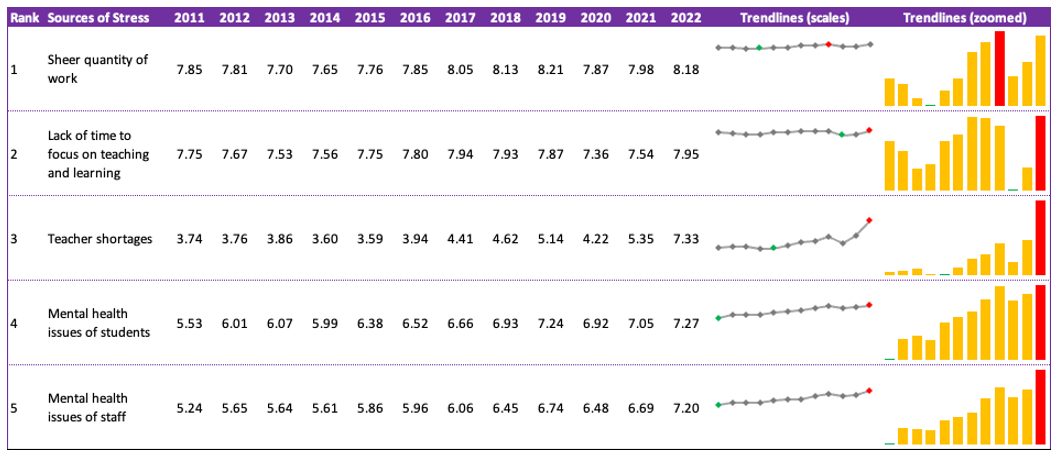
The number of Australian principals planning to quit or retire has tripled over the last four years with teacher shortages a main driver of the profession’s stress, according to a damning new survey of 2,500 principals.
Figures compiled by the Australian Catholic University’s Institute for Positive Psychology and Education (IPPE) for the latest annual survey of Australian school leaders reveal 65 principals planned to quit or retire early in 2022 – more than triple the number in 2019.
ACU Investigator and former principal Dr Paul Kidson said while the raw number was low, it represented a substantial increase which pointed to a worrying trend supported by the other findings.
“It is a drastic increase when you look at the whole picture,” Dr Kidson said.

‘Unsustainable levels’
Dr Kidson said principals’ workloads, stress caused by issues including the national teacher shortage across public, Catholic, and independent schools, and demands outside the classroom have “escalated to unsustainable levels.”
“We are now seeing the cumulative impact of this on principals’ health and wellbeing, and we are very concerned about the increasing steepness of those trends as they are heading in a very distressing direction,” he said.
“This data shows serious dashboard warning lights flashing all over the place. These are warning signs that we have not seen so acutely before, and we have almost 2,500 people saying the same thing.”
Australian Principal Occupational Health, Safety and Wellbeing Survey’s co-lead investigator and leading school wellbeing expert, Associate Professor Theresa Dicke, of ACU’s Institute for Positive Psychology in Education, said despite efforts to stop the problem in its tracks, it’s not just persisting, but worsening.
“Based on our most recent data it certainly looks like it is worsening across Australia,” Associate Professor Dicke told The Educator.
“It is very concerning to see downward trends and upswings in all the wrong places. For the first time, our research has also shown a spike in the number of principals expressing their intention to quit or retire early.”
‘A very concerning future trend’
Associate Professor Dicke said the increase in principals voicing intentions to quit or retire points to “a very concerning future trend”.
“It shows just how much their health and wellbeing is at risk. We know principals have been shouldering the load for some time now and the survey results certainly reflect this,” she said.
“We have almost 2,500 Australian principals telling us louder than ever before that they are stressed and that their health and wellbeing is suffering. And this is just the early data from our comprehensive annual study.”
Associate Professor Dicke said these findings will be further supported by a range of data being prepared for the Australian Principal Occupational Health, Safety and Wellbeing Survey 2022 being released in March.

‘Better targeted strategies are needed’
World leading educational psychologist and co-lead investigator Professor Herb Marsh, of ACU’s Institute for Positive Psychology in Education, said better targeted strategies are needed to reverse these serious trends before they get even worse.
“While the sheer quantity of work and the lack of time to focus on teaching and learning have been the greatest source of stress for leaders over the last 13 years, teacher shortages jumped to the third highest source of stress in this year’s survey – a huge increase since 2021,” Professor Marsh told The Educator.
“Mental Health issues with students and mental health issues with staff were also at an all-time high in 2022. Reflecting this there was a substantial increase in the reports of school principals wanting to retire early or leave the profession.”
Professor Marsh said the teacher shortage is adversely impacting on principals’ mental health and wellbeing as they continue to be charged with the responsibility to find relief teachers to cover absences, continue to deliver positive student outcomes, keep up with administrative tasks, and fill many other gaps.
“This new significant contributing factor to principals’ worsening health and wellbeing is also an ongoing problem, meaning it is taking its toll on hard working school leaders every single day,” he said.
“Not only are each of these top five sources of stress significant in terms of their detrimental individual impact on school principals, collectively they are compounding the serious mental and physical health burdens on our school leaders.”
Professor Marsh said the research also shows that despite the increased stresses on them directly, principals are concerned about the health and wellbeing of their staff and students.
“This raises other contributing factors behind the findings with issues such as school refusal among students, and burnout among staff becoming more problematic.”
Where to from here?
Associate Professor Dicke said while various initiatives aimed at addressing the profession’s most serious challenges are good intentioned, much more needs to be done.
“We acknowledge that these are systemic and challenging problems and that state and federal governments have implemented some measures to support school leaders, but this survey is showing that principals don’t feel these initiatives go far enough,” she said.
“They still feel heavily burdened by the demands of their jobs and their responses to the survey questions show more needs to be done.”
Associate Professor Dicke said principals need meaningful change to occur to help them feel supported and empowered in their important roles as leaders in their schools and communities.
“Political leaders and education experts have united to form the National Teacher Workforce Action Plan, so we know there is a precedent here for a collaborative effort aimed at improving the health and wellbeing of principals,” she said.
“The new Plan has good intentions, especially due to the serious impact teacher shortages are now having on principals, but it would be even more effective with more principal-specific initiatives and the ongoing support they need to implement it.”


